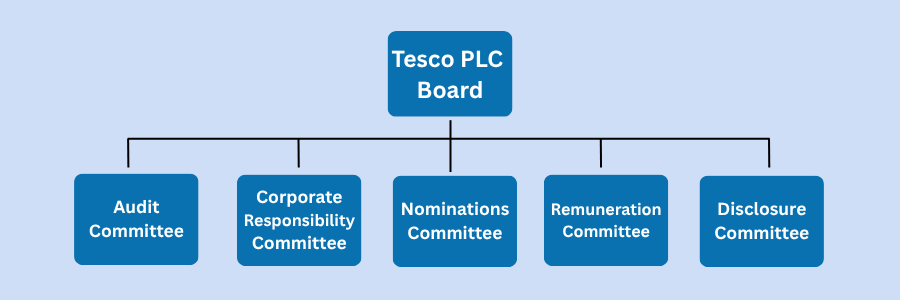Understanding Tesco
Tesco PLC is a multinational grocery and public merchandise retailer. Tesco began in London's East End in 1919. Jack Cohen used his savings to buy surplus groceries and sell them from a market stall. In 1924, it launched its first branded product, which was named Tesco Tea. It helps them establish the firm's name. However, Tesco not only leads multinational retailers but is also the biggest supermarket chain in the UK with almost 4000 stores. Do you know what is Tesco's organisational structure? If not, then you can read this guide to get a better insight!
Tesco's Organisational Structure
Tesco has a hierarchical and decentralized organizational structure. Plus, Tesco organisational structure diagram consists of three groups of employees: the top, middle and base level of management.
Top-Level and Mediate Level
At the highest level, Tesco is governed by a board of ten directors, led by Chief Executive Officer (CEO) Ken Murphy. Below this, the second tier has five principal committees: audit committee, corporate responsibility committee, nominations committee, remuneration committee, and disclosure committee.

Base Level
After this, there is a base level of management. Here, employees are divided into specific regions. At the top of the Tesco organisation chart is a regional manager. Then, there's a store manager and three other managers below them, who are food trading, non-food trading, and personnel managers. Each of the three managers has team members such as fresh food section managers, ambient food section managers, electrical section managers, clothing section managers, and personnel assistants.

Now you have an fair idea about what organisational structure is Tesco and how it supports its daily operations. Next, its time to explore its pros and cons.
Key Characteristics - Tesco Hierarchical Structure
- Hierarchical: Tesco organizational structure is tall and pyramidal, with several layers of management. This creates a clear chain of command.
- Span of control: Tesco has a tall organizational structure characterized by a narrower span of control, meaning each manager manages a smaller number of individuals.
- Empowerment: The Tesco structure empowers employees and encourages employees at all levels to take responsibility and make decisions. It gives them a sense of involvement in the business.
- Decentralized: Tesco management structure gives freedom to its store manager to make operational decisions in a way that best meets local needs.
Advantages and Disadvantages of Tesco Organisational Structure
The Tesco business structure consists of both advantages and disadvantages. Below is the list mentioned. Keep reading to know more!
Advantages:
- Specialization: A functional structure enables departments to specialize in specific areas like marketing and finance.
- Access to Capital: It is a PLC (public limited company), which makes it easier to increase capital by selling shares to the public.
- Economies of Scale: Being a large PLC, it can negotiate for more reasonable prices with suppliers & get economies of scale.
- Career Progression: The tall hierarchy provides a chance for employees to advance their careers, as it creates many management layers.
- Local Decision-Making: The tall structure allows local and regional managers to make decisions that suit their local areas, which can improve customer satisfaction.
Disadvantages:
- Public Scrutiny: Being a PLC, Tesco Organisational Structure pdf faces significant public scrutiny because its official statements are public.
- Slow Decision-Making: The long chain of command means that decision-making can take a long time.
- Reduced Employee Motivation: Plus, employees can feel less encouraged if they are given fewer responsibilities.
- Segregation and Lack of Coordination: Departments can become segregated, which might result in the lack of overall coordination.
- Poor Inter-Departmental Communication: The division of departments can lead to poor coordination & communication between them.
Conclusion
In summary, the organizational structure of Tesco plays a significant role in its success. Decentralisation enables store managers to make decisions that are suitable for local customers, while the clear chain of command ensures accountability. The combination of control and flexibility undoubtedly enables Tesco to continue to be efficient and responsive in a competitive retail market. Comparing this to Sainsbury's organizational structure, it is evident that diverse types of management and decision making affect the operations of each retailer, customer convenience, as well as performance throughout their stores.



 Company
Company


















